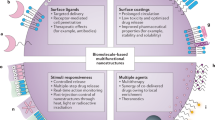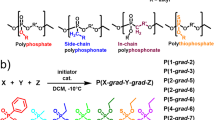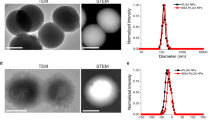Abstract
Nanocomposites are widely used to obtain an accurate diagnosis of, and to provide effective therapy for, a number of diseases, because they can be easily formulated by introducing therapeutic agents (e.g., drugs and genes) and imaging agents (e.g., magnetic nanocrystals). Furthermore, nanocomposites can be developed as all-in-one systems, which enable cancer diagnosis and therapy, as well as the simultaneous monitoring of drug behavior. In this protocol, we describe the synthesis of four pyrenyl-based polymers (pyrenyl polyethylene glycol (Py-PEG), pyrenyl dextran (Py-DEX), pyrenyl hyaluronan (Py-HA) and pyrenyl-conjugated heterofunctional PEG (pyrenyl PEG)) and their subsequent use in the preparation of multifunctional nanocomposites for different applications including multimodal imaging, targeted cancer detection and pH-sensitive drug delivery. Notably, these nanocomposites can be used to simultaneously perform multiple tasks—for example, delivering magnetic particles for early cancer detection by MRI, efficient cataloging of patient groups for personalized therapy and real-time monitoring of disease progress. Starting from the synthesis of pyrenyl-based polymers, this protocol can be completed in ∼15 d.
This is a preview of subscription content, access via your institution
Access options
Subscribe to this journal
Receive 12 print issues and online access
$259.00 per year
only $21.58 per issue
Buy this article
- Purchase on Springer Link
- Instant access to full article PDF
Prices may be subject to local taxes which are calculated during checkout















Similar content being viewed by others
References
Boulaiz, H. et al. Nanomedicine: application areas and development prospects. Int. J. Mol. Sci. 12, 3303–3321 (2011).
Haam, S., Lee, K., Yang, J. & Huh, Y.M. Nanotechnologies for the Life Sciences (Wiley, 2012).
Huang, C.K., Lo, C.L., Chen, H.H. & Hsiue, G.H. Multifunctional micelles for cancer cell targeting, distribution imaging, and anticancer drug delivery. Adv. Funct. Mater. 17, 2291–2297 (2007).
Kao, J., Thorkelsson, K., Bai, P., Rancatore, B.J. & Xu, T. Toward functional nanocomposites: taking the best of nanoparticles, polymers, and small molecules. Chem. Soc. Rev. 42, 2654–2678 (2013).
Kawasaki, E.S. & Player, A. Nanotechnology, nanomedicine, and the development of new, effective therapies for cancer. Nanomedicine 1, 101–109 (2005).
Kim, D.K. & Dobson, J. Nanomedicine for targeted drug delivery. J. Mater. Chem. 19, 6294–6307 (2009).
Lee, D.E. et al. Multifunctional nanoparticles for multimodal imaging and theragnosis. Chem. Soc. Rev. 41, 2656–2672 (2012).
Liong, M. et al. Multifunctional inorganic nanoparticles for imaging, targeting, and drug delivery. ACS Nano 2, 889–896 (2008).
Liu, Y., Miyoshi, H. & Nakamura, M. Nanomedicine for drug delivery and imaging: a promising avenue for cancer therapy and diagnosis using targeted functional nanoparticles. Int. J. Cancer. 120, 2527–2537 (2007).
Nasongkla, N. et al. Multifunctional polymeric micelles as cancer-targeted, MRI-ultrasensitive drug delivery systems. Nano Lett. 6, 2427–2430 (2006).
Peer, D. et al. Nanocarriers as an emerging platform for cancer therapy. Nat. Nanotechnol. 2, 751–760 (2007).
Ryu, J.H. et al. Tumor-targeting multi-functional nanoparticles for theragnosis: new paradigm for cancer therapy. Adv. Drug. Deliv. Rev. 64, 1447–1458 (2012).
Veiseh, O., Gunn, J.W. & Zhang, M. Design and fabrication of magnetic nanoparticles for targeted drug delivery and imaging. Adv. Drug. Deliv. Rev. 62, 284–304 (2010).
Lim, E.K. et al. Nanomaterials for theranostics: recent advances and future challenges. Chem. Rev. 115, 327–394 (2015).
Barreto, J.A. et al. Nanomaterials: applications in cancer imaging and therapy. Adv. Mater. 23, H18–H40 (2011).
Xie, J., Lee, S. & Chen, X. Nanoparticle-based theranostic agents. Adv. Drug. Deliv. Rev. 62, 1064–1079 (2010).
Agasti, S.S. et al. Nanoparticles for detection and diagnosis. Adv. Drug. Deliv. Rev. 62, 316–328 (2010).
Pene, F., Courtine, E., Cariou, A. & Mira, J.P. Toward theragnostics. Crit. Care Med. 37, S50–S58 (2009).
Chow, E.K. & Ho, D. Cancer nanomedicine: from drug delivery to imaging. Sci. Transl. Med. 5, 216rv4 (2013).
Albanese, A., Tang, P.S. & Chan, W.C. The effect of nanoparticle size, shape, and surface chemistry on biological systems. Annu. Rev. Biomed. Eng. 14, 1–16 (2012).
Lim, E.K., Jang, E., Lee, K., Haam, S. & Huh, Y.M. Delivery of cancer therapeutics using nanotechnology. Pharmaceutics 5, 294–317 (2013).
Tong, R. & Cheng, J. Anticancer polymeric nanomedicines. Polym. Rev. 47, 345–381 (2007).
Lim, E.-K., Haam, S., Lee, K. & Huh, Y.-M. in Bioconjugation Protocols: Strategies and Methods 583–595 (Springer, 2011).
Solans, C., Izquierdo, P., Nolla, J., Azemar, N. & Garciacelma, M. Nano-emulsions. Curr. Opin. Colloid Interface Sci. 10, 102–110 (2005).
Zhang, T., Ge, J., Hu, Y. & Yin, Y. A general approach for transferring hydrophobic nanocrystals into water. Nano Lett. 7, 3203–3207 (2007).
Lee, J.H. et al. Artificially engineered magnetic nanoparticles for ultra-sensitive molecular imaging. Nat. Med. 13, 95–99 (2007).
Kwon, S.G. et al. Kinetics of monodisperse iron oxide nanocrystal formation by “heating-up” process. J. Am. Chem. Soc. 129, 12571–12584 (2007).
Park, J., Joo, J., Kwon, S.G., Jang, Y. & Hyeon, T. Synthesis of monodisperse spherical nanocrystals. Angew. Chem. Int. Ed. Engl. 46, 4630–4660 (2007).
Lee, J. et al. Smart nanoprobes for ultrasensitive detection of breast cancer via magnetic resonance imaging. Nanotechnology 19, 485101 (2008).
Lim, E.K. et al. pH-triggered drug-releasing magnetic nanoparticles for cancer therapy guided by molecular imaging by MRI. Adv. Mater. 23, 2436–2442 (2011).
Lim, E.K. et al. Synthesis of water soluble PEGylated magnetic complexes using mPEG-fatty acid for biomedical applications. Colloids Surf. B Biointerfaces 64, 111–117 (2008).
Lim, E.-K. et al. Self-assembled fluorescent magnetic nanoprobes for multimode-biomedical imaging. Biomaterials 31, 9310–9319 (2010).
Yang, J. et al. Synthesis of ultrasensitive magnetic resonance contrast agents for cancer imaging using PEG-fatty acid. Chem. Mater. 19, 3870–3876 (2007).
Cho, E.-J. et al. Sensitive angiogenesis imaging of orthotopic bladder tumors in mice using a selective magnetic resonance imaging contrast agent containing VEGF121-rGel. Invest. Radiol. 46, 441–449 (2011).
Lim, E.-K., Yang, J., Suh, J.-S., Huh, Y.-M. & Haam, S. Self-labeled magneto nanoprobes using tri-aminated polysorbate 80 for detection of human mesenchymal stem cells. J. Mater. Chem. 19, 8958–8963 (2009).
Lim, E.K. et al. Aptamer-conjugated magnetic nanoparticles enable efficient targeted detection of integrin αvβ3 via magnetic resonance imaging. J. Biomed. Mater. Res. A. 102, 49–59 (2014).
Lim, E.K., Yang, J., Suh, J.S., Huh, Y.M. & Haam, S. Synthesis of aminated polysorbate 80 for polyplex-mediated gene transfection. Biotechnol. Prog. 26, 1528–1533 (2010).
Zhu, S. et al. Partly PEGylated polyamidoamine dendrimer for tumor-selective targeting of doxorubicin: the effects of PEGylation degree and drug conjugation style. Biomaterials 31, 1360–1371 (2010).
Zhang, K. et al. PEG-PLGA copolymers: their structure and structure-influenced drug delivery applications. J. Control. Release 183, 77–86 (2014).
Veronese, F.M. & Pasut, G. PEGylation, successful approach to drug delivery. Drug Discov. Today 10, 1451–1458 (2005).
Byrne, J.D., Betancourt, T. & Brannon-Peppas, L. Active targeting schemes for nanoparticle systems in cancer therapeutics. Adv. Drug Deliv. Rev. 60, 1615–1626 (2008).
Gao, J. et al. Affibody-based nanoprobes for HER2-expressing cell and tumor imaging. Biomaterials 32, 2141–2148 (2011).
Wuang, S.C., Neoh, K.G., Kang, E.T., Pack, D.W. & Leckband, D.E. HER-2-mediated endocytosis of magnetic nanospheres and the implications in cell targeting and particle magnetization. Biomaterials 29, 2270–2279 (2008).
Phan, V.N. et al. A highly crystalline manganese-doped iron oxide nanocontainer with predesigned void volume and shape for theranostic applications. Adv. Mater. 25, 3202–3208 (2013).
Choi, R. et al. Thiolated dextran-coated gold nanorods for photothermal ablation of inflammatory macrophages. Langmuir 26, 17520–17527 (2010).
Jang, E. et al. π-Hyaluronan nanocarriers for CD44-targeted and pH-boosted aromatic drug delivery. J. Mater. Chem. B 1, 5686 (2013).
Kim, E. et al. Hyaluronic acid receptor-targetable imidazolized nanovectors for induction of gastric cancer cell death by RNA interference. Biomaterials 34, 4327–4338 (2013).
Kim, M.H. et al. Magnetic nanoclusters engineered by polymer-controlled self-assembly for the accurate diagnosis of atherosclerotic plaques via magnetic resonance imaging. Macromol. Biosci. 14, 943–952 (2014).
Lim, E.K. et al. Hyaluronan-modified magnetic nanoclusters for detection of CD44-overexpressing breast cancer by MR imaging. Biomaterials 32, 7941–7950 (2011).
Lim, E.-K. et al. Dextran-coated magnetic nanoclusters as highly sensitive contrast agents for magnetic resonance imaging of inflammatory macrophages. J. Mater. Chem. 21, 12473 (2011).
Lim, E.-K. et al. Self-fabricated dextran-coated gold nanoparticles using pyrenyl dextran as a reducible stabilizer and their application as CT imaging agents for atherosclerosis. J. Mater. Chem. 22, 17518 (2012).
Namazi, H., Fathi, F. & Heydari, A. The Delivery of Nanoparticles 149–184 (InTech, 2012).
Sihorkar, V. & Vyas, S.P. Potential of polysaccharide anchored liposomes in drug delivery, targeting and immunization. J. Pharm. Pharm. Sci. 4, 138–158 (2001).
Talanov, V.S. et al. Dendrimer-based nanoprobe for dual modality magnetic resonance and fluorescence imaging. Nano Lett. 6, 1459–1463 (2006).
Yang, S.-H. et al. Galactosylated manganese ferrite nanoparticles for targeted MR imaging of asialoglycoprotein receptor. Nanotechnology 24, 475103 (2013).
Yhee, J.-Y. et al. Self-assembled glycol chitosan nanoparticles for disease-specific theranostics. J. Control. Release 193, 202–213 (2014).
Yoon, H.Y. et al. Glycol chitosan nanoparticles as specialized cancer therapeutic vehicles: sequential delivery of doxorubicin and Bcl-2 siRNA. Sci. Rep. 4, 6878–6890 (2014).
Dufes, C. et al. Anticancer drug delivery with transferrin targeted polymeric chitosan vesicles. Pharm. Res. 21, 101–107 (2004).
Lee, T. et al. Efficient CD44-targeted magnetic resonance imaging (MRI) of breast cancer cells using hyaluronic acid (HA)-modified MnFe2O4 nanocrystals. Nanoscale Res. Lett. 8, 149 (2013).
Lee, J.-H. et al. Dual-mode nanoparticle probes for high-performance magnetic resonance and fluorescence imaging of neuroblastoma. Angew. Chem. Int. Ed. Engl. 45, 8160–8162 (2006).
Gianella, A. et al. Multifunctional nanoemulsion platform for imaging guided therapy evaluated in experimental cancer. ACS Nano 5, 4422 (2011).
Kim, E. et al. Imidazole magnetic nanovectors with endosome disrupting moieties for the intracellular delivery of imaging of siRNA. J. Mater. Chem. B 2, 8566 (2014).
Fleige, E. et al. Stimuli-responsive polymeric nanocarriers for the controlled transport of active compounds: concepts and applications. Adv. Drug. Deliv. Rev. 64, 866 (2012).
Liu, Z., Tabakman, S.M., Chen, Z. & Dai, H. Preparation of carbon nanotube bioconjugates for biomedical applications. Nat. Protoc. 4, 1372–1382 (2009).
Lim, E.K. et al. Gadolinium-based nanoparticles for highly efficient T1-weighted magnetic resonance imaging. Nanotechnology 25, 245103 (2014).
Pavlov, A.M. et al. Magnetically engineered microcapsules as intracellular anchors for remote control over cellular mobility. Adv. Mater. 25, 6945–6950 (2013).
Li, Z. et al. Magnetic targeting enhanced theranostic strategy based on multimodal imaging for selective ablation of cancer. Adv. Funct. Mater. 24, 2312–2321 (2014).
Ryu, Y. et al. Size-controlled construction of magnetic nanoparticle clusters using DNA-binding zinc finger protein. Angew. Chem. Int. Ed. Engl. 54, 923–926 (2015).
Liu, C. et al. Magnetic/upconversion fluorescent NaGdF4;Yb,Er nanoparticle-based dual-modal molecular probes for imaging tiny tumors in vivo. ACS Nano 7, 7227–7240 (2013).
Yoo, D., Jeong, H., Noh, S.H., Lee, J.H. & Cheon, J. Magnetically triggered dual functional nanoparticles for resistance-free apoptotic hyperthermia. Angew. Chem. Int. Ed. Engl. 52, 13047–13051 (2013).
Arami, H. et al. In vivo multimodal magnetic particle imaging (MPI) with tailored magneto/optical contrast agents. Biomaterials 52, 251–261 (2015).
Yang, J. et al. Fluorescent magnetic nanohybrids as multimodal imaging agents for human epithelial cancer detection. Biomaterials 29, 2548–2555 (2008).
Zhang, L. et al. Magnetic/upconversion luminescent mesoparticles of Fe3O4@LaF3:Yb3+, Er3+ for dual-modal bioimaging. Chem. Commun. 48, 11238–11240 (2012).
Kim, J. et al. Magnetic fluorescent delivery vehicle using uniform mesoporous silica spheres embedded with monodisperse magnetic and semiconductor nanocrystals. J. Am. Chem. Soc. 128, 688–689 (2006).
Ryu, J. et al. Facile synthesis of ultrasmall and hexagonal NaGdF4: Yb3+, Er3+ nanoparticles with magnetic and upconversion imaging properties. J. Phys. Chem. C 114, 21077–21082 (2010).
Cong, H.P., He, J.J., Lu, Y. & Yu, S.H. Water-soluble magnetic-functionalized reduced graphene oxide sheets: in situ synthesis and magnetic resonance imaging applications. Small 6, 169–173 (2010).
Kamada, H. et al. Synthesis of a poly(vinylpyrrolidone-co-dimethyl maleic anhydride) co-polymer and its application for renal drug targeting. Nat. Biotechnol. 21, 399–404 (2003).
Stuart, M.A.C. et al. Emerging applications of stimuli-responsive polymer materials. Nat. Mater. 9, 101–113 (2010).
Popat, A. et al. Programmable drug release using bioresponsive mesoporous silica nanoparticles for site-specific oral drug delivery. Chem. Commun. 50, 5547–5550 (2014).
Lee, J.H. et al. All-in-one target-cell-specific magnetic nanoparticles for simultaneous molecular imaging and siRNA delivery. Angew. Chem. Int. Ed. Engl. 48, 4174–4179 (2009).
Kamada, H. et al. Design of a pH-sensitive polymeric carrier for drug release and its application in cancer therapy. Clin. Cancer Res. 10, 2545–2550 (2004).
Meyer, M., Zintchenko, A., Ogris, M. & Wagner, E. A dimethylmaleic acid-melittin-polylysine conjugate with reduced toxicity, pH-triggered endosomolytic activity and enhanced gene transfer potential. J. Gene Med. 9, 797–805 (2007).
You, J.O. & Auguste, D.T. The effect of swelling and cationic character on gene transfection by pH-sensitive nanocarriers. Biomaterials 31, 6859–6866 (2010).
Zhou, L. et al. Endosomal pH-activatable poly(ethylene oxide)-graft-doxorubicin prodrugs: synthesis, drug release, and biodistribution in tumor-bearing mice. Biomacromolecules 12, 1460–1467 (2011).
Kim, J.K. et al. Novel pH-sensitive polyacetal-based block copolymers for controlled drug delivery. Int. J. Pharm. 401, 79–86 (2010).
Sato, K., Yoshida, K., Takahashi, S. & Anzai, J. pH- and sugar-sensitive layer-by-layer films and microcapsules for drug delivery. Adv. Drug Deliv. Rev. 63, 809–821 (2011).
Du, Y., Chen, W., Zheng, M., Meng, F. & Zhong, Z. pH-sensitive degradable chimaeric polymersomes for the intracellular release of doxorubicin hydrochloride. Biomaterials 33, 7291–7299 (2012).
Wang, C.-Y. & Huang, L. pH-sensitive immunoliposomes mediate target-cell-specific delivery and controlled expression of a foreign gene in mouse. Proc. Natl. Acad. Sci. USA 84, 7851–7855 (1987).
Ko, J.Y. et al. pH-sensitive nanoflash for tumoral acidic pH imaging in live animals. Small 6, 2539–2544 (2010).
Hayashi, H., Iijima, M., Kataoka, K. & Nagasaki, Y. pH-sensitive nanogel possessing reactive PEG tethered chains on the surface. Macromolecules 37, 5389–5396 (2004).
Jung, J., Lee, I.-H., Lee, E., Park, J. & Jon, S. pH-sensitive polymer nanospheres for use as a potential drug delivery vehicle. Biomacromolecules 8, 3401–3407 (2007).
Felber, A.E., Dufresne, M.H. & Leroux, J.C. pH-sensitive vesicles, polymeric micelles, and nanospheres prepared with polycarboxylates. Adv. Drug Deliv. Rev. 64, 979–992 (2012).
Chen, Z., Xu, L., Liang, Y. & Zhao, M. pH-sensitive water-soluble nanospheric imprinted hydrogels prepared as horseradish peroxidase mimetic enzymes. Adv. Mater. 22, 1488–1492 (2010).
Fleige, E., Quadir, M.A. & Haag, R. Stimuli-responsive polymeric nanocarriers for the controlled transport of active compounds: concepts and applications. Adv. Drug Deliv. Rev. 64, 866–884 (2012).
Shim, M.S. & Kwon, Y.J. Stimuli-responsive polymers and nanomaterials for gene delivery and imaging applications. Adv. Drug Deliv. Rev. 64, 1046–1059 (2012).
Lee, E.S., Na, K. & Bae, Y.H. Super pH-sensitive multifunctional polymeric micelle. Nano Lett. 5, 325–329 (2005).
Son, Y.J., Kim, H., Leong, K.W. & Yoo, H.S. Multifunctional nanorods serving as nanobridges to modulate T cell-mediated immunity. ACS Nano 7, 9771–9779 (2013).
Kim, J. et al. Multifunctional uniform nanoparticles composed of a magnetite nanocrystal core and a mesoporous silica shell for magnetic resonance and fluorescence imaging and for drug delivery. Angew. Chem. Int. Ed. Engl. 47, 8438–8441 (2008).
Kim, E. et al. Imidazolized magnetic nanovectors with endosome disrupting moieties for the intracellular delivery and imaging of siRNA. J. Mater. Chem. B 2, 8566–8575 (2014).
Kester, M. et al. Calcium phosphate nanocomposite particles for in vitro imaging and encapsulated chemotherapeutic drug delivery to cancer cells. Nano Lett. 8, 4116–4121 (2008).
Lee, G.Y. et al. Theranostic nanoparticles with controlled release of gemcitabine for targeted therapy and MRI of pancreatic cancer. ACS Nano 26, 2078–2089 (2013).
Kievit, F.M. & Zhang, M. Cancer nanotheranostics: improving imaging and therapy by targeted delivery across biological barriers. Adv. Mater. 23, H217–H247 (2011).
Lim, E.-K. et al. Chitosan-based intelligent theragnosis nanocomposites nanocomposites enable pH-sensitive drug release with MR-guided imaging for cancer therapy. Nanoscale Res. Lett. 8, 467–479 (2013).
Yu, M.K. et al. Drug-loaded superparamagnetic iron oxide nanoparticles for combined cancer imaging and therapy in vivo. Angew. Chem. Int. Ed. Engl. 47, 5362–5365 (2008).
Gillies, E.R. & Fréchet, J.M.J pH responsive copolymer assemblies for controlled release of doxorubicin. Bioconjug. Chem. 16, 361–368 (2005).
Veiseh, O., Kievit, F.M., Ellenbogen, R.G. & Zhang, M. Cancer cell invasion: treatment and monitoring opportunities in nanomedicine. Adv. Drug Deliv. Rev. 63, 582–596 (2011).
Guo, X. et al. pH-triggered intracellular release from actively targeting polymer micelles. Biomaterials 34, 4544–4554 (2013).
Guo, X. et al. Dual-responsive polymer micelles for target-cell-specific anticancer drug delivery. Chem. Mater. 16, 4405–4418 (2014).
Sun, S. et al. Monodisperse MFe2O4 (M = Fe, Co, Mn) nanoparticles. J. Am. Chem. Soc. 126, 273–279 (2004).
Lim, E.-K., Haam, S., Lee, K. & Huh, Y.-M. Design and synthesis of biofunctionalized metallic/magnetic nanomaterials. Methods. Mol. Biol. 751, 583–595 (2011).
Shoaib, M.H., Tazeen, J., Merchant, H.A. & Yousuf, R.I. Evaluation of drug release kinetics from ibuprofen matrix tablets using HPMC. J. Pharm. Sci. 19, 119–124 (2006).
Acknowledgements
This study was supported by a grant from the BioNano Health Guard Research Center funded by the Ministry of Science, ICT and Future Planning (MSIP) of Korea as a Global Frontier Project (H-GUARD_2013 M3A6B2078950), National Research Foundation of Korea (NRF) funded by the Ministry of Education Science and Technology (NRF-2012R1A1A2043991; NRF-2014M3A6B2060507) and KRIBB Research Initiative Program.
Author information
Authors and Affiliations
Contributions
E.-K.L. conceived and wrote this paper. E.-K.L. and B.H.C. revised the paper.
Corresponding author
Ethics declarations
Competing interests
The authors declare no competing financial interests.
Rights and permissions
About this article
Cite this article
Lim, EK., Chung, B. Preparation of pyrenyl-based multifunctional nanocomposites for biomedical applications. Nat Protoc 11, 236–251 (2016). https://doi.org/10.1038/nprot.2015.135
Published:
Issue Date:
DOI: https://doi.org/10.1038/nprot.2015.135
This article is cited by
-
Recent Approaches on the Application of Agro Waste Derived Biocomposites as Green Support Matrix for Enzyme Immobilization
Journal of Polymers and the Environment (2022)
Comments
By submitting a comment you agree to abide by our Terms and Community Guidelines. If you find something abusive or that does not comply with our terms or guidelines please flag it as inappropriate.



